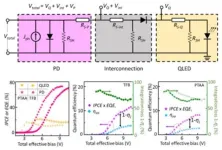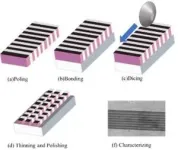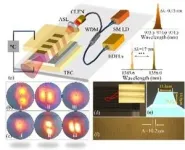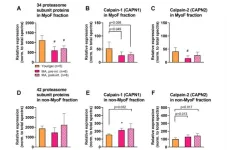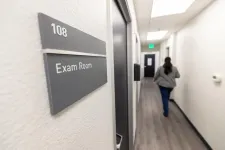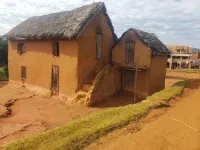A new publication from Opto-Electronic Science; DOI 10.29026/oes.2024.230029 discusses unraveling the efficiency losses and improving methods in quantum dot-based infrared up-conversion photodetectors.
Traditional infrared imagers are usually constructed by bonding an infrared PD with each pixel of a thin film transistor (TFT)-based active-matrix backplane. A feasible way to avoid the costly pixilation is to use infrared up-conversion photodetector, in which an infrared photodetector (PD) and a light-emitting diode (LED) with large effective areas are back-to-back connected. With excitations from infrared signals, the holes from photoexcitation in the PD unit and electrons from external injection are radiatively recombined to turn on the LED unit. Without infrared signals, the up-conversion photodetectors keep dark. Therefore, infrared imaging based on up-conversion photodetectors neither needs discrete pixels, nor the expensive indium pillar welding process. Recently, lead sulfide (PbS) and cadmium selenide (CdSe) colloidal quantum dots (CQDs) have been reported to work as infrared active materials and visible emitting materials in infrared up-conversion photodetectors, respectively. When PbS-based PD and CdSe-based QLED work alone, the photon-to-electron conversion efficiency (IPCE) of the PD and the electron-to-photon conversion efficiency (EQE) the QLED can be as high as 104% and 25%, respectively. However, when the CQDs-based PD and QLED were integrated into the up-conversion photodetectors, the highest reported ηpp was only 6.5%. In previous works, the efficiency of the all-CQD up-conversion devices was improved by adjusting the optimized working voltages of the QLED unit or the optimized thickness of the infrared absorbing layer in the PD unit. However, these improvements were just based on empirical experiences and experimental attempts, and there haven’t been sufficient understandings on the origins of the huge efficiency losses after the high-performance PDs and QLEDs are integrated together to form up-conversion photodetectors. It's important to fully understand the huge efficiency losses and how the PD and QLED units constrain each other in the up-conversion photodetectors for further improvements.
The authors of this article propose a circuit model for quantum dot-based up-conversion photodetectors, so that the effective biases allocated among different units in the up-conversion photodetectors were quantitatively analyzed. Based on the understanding on the mechanisms of allocating effective bias onto different units in the up-conversion photodetectors, the efficiency losses and how the PD and QLED units constrain each other in the up-conversion photodetectors were elaborated. One of the main limits to the efficiency of up-conversion photodetectors was the poor matching between PD unit and QLED units. Though the quantum efficiency of the QLED unit achieved its maximum under low working bias (< 6V) in up-conversion devices, the effective IPCE of the PD unit was very low and the integration loss (1- ηi) was very high, leading to low infrared photon-to-visible photon conversion efficiency (ηpp). The low effective IPCE originated from the small effective bias allocated onto the PD unit. With low working bias (< 6 V), the photogenerated holes cannot overcome the interconnection barrier. Lots of photogenerated carriers were accumulated and recombined at the interface, leading to high integration loss (~80%) at low working bias. With high working bias (~ 10 V), the PD unit achieved its maximum IPCE, while the EQE of the QLED unit might decrease due to efficiency roll-off, resulting in significant efficiency loss in up-conversion devices. Since the PD unit must achieve high IPCE under large working bias in up-conversion device, improving the matching between the PD unit and QLED unit usually rely on using a QLED with minimal efficiency roll-off. This indicated that pursing high maximum EQE in QLEDs under low working bias was meaningless for improving the performance of up-conversion devices. By integrating a QLED with minimal efficiency roll-off, the performances of the up-conversion device improved significantly. On the other hand, the integration losses of the up-conversion devices were still over 65%, regardless of whether high-barrier or low-barrier interconnection layers were used. This significant loss was mainly contributed by the absorption of the visible emission in PbS layers. Reducing the thicknesses of PbS layers brought moderate improvement in ηpp of the up-conversion device through a balanced infrared absorption and visible transmission in PbS layers. Finally, the suppressed efficiency roll-off in QLED unit, together with optimized PbS layers, resulted in a breakthrough ηpp of 6.9%.
More sophisticated optical structure, such as micro-cavity or plasmonic structure, may bring additional room for optimizing the performances of quantum dot-based up-conversion devices. On the other hand, the voltage loss at the interconnection is still significant. It’s necessary to further reducing the hole injection barriers at the interconnection between the PD unit and QLED unit, so that the up-conversion photodetectors can work with < 1 V bias. Theoretically, self-driven up-conversion photodetectors can be realized with tandem PD units, which need more careful engineering work.
# # # # # #
Prof. Zhenghui Wu and Prof. Huaibin Shen are from the same research group, which is affiliated to School of Materials in Henan University and the Key Lab for Special Functional Materials, Ministry of Education. Other team members of the research group include 8 research scholars with Ph.D. degree and over 50 postgraduate students. The research group mainly conducts fundamental research related to colloidal quantum dot (CQDs), including chemical synthesis of CQDs, engineering and characterization of the optoelectronic properties of CQDs, as well as the device physics of CQD-based optoelectronic devices. The researches on the visible-emitting CQDs and quantum dot-light emitting diodes (QLEDs) have been lasted for more than 20 years, and published hundreds of high-impact articles in well-known journals such as Nature Photonics, Nature Nanotechnology, Coordination Chemistry Reviews, Nano Letters, Advanced Functional Materials, and etc. The researches on infrared absorbing CQDs like PbS, PbSe, and HgTe CQDs have started several years ago.
# # # # # #
Opto-Electronic Science (OES) is a peer-reviewed, open access, interdisciplinary and international journal published by The Institute of Optics and Electronics, Chinese Academy of Sciences as a sister journal of Opto-Electronic Advances (OEA, IF=9.682). OES is dedicated to providing a professional platform to promote academic exchange and accelerate innovation. OES publishes articles, reviews, and letters of the fundamental breakthroughs in basic science of optics and optoelectronics.
# # # # # #
More information: https://www.oejournal.org/oes
Editorial Board: https://www.oejournal.org/oes/editorialboard/list
OES is available on OE journals (https://www.oejournal.org/oes/archive)
Submission of OES may be made using ScholarOne (https://mc03.manuscriptcentral.com/oes)
CN 51-1800/O4
ISSN 2097-0382
Contact Us: oes@ioe.ac.cn
Twitter: @OptoElectronAdv (https://twitter.com/OptoElectronAdv?lang=en)
WeChat: OE_Journal
# # # # # #
Liu JJ, Yang XX, Xu QL et al. Unraveling the efficiency losses and improving methods in quantum dot-based infrared up-conversion photodetectors. Opto-Electron Sci 3, 230029 (2024). doi: 10.29026/oes.2024.230029
END
